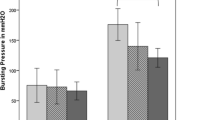Abstract
Purpose
Use of biosutures in animal models of colonic anastomoses is associated with decreased adhesions without affecting anastomotic strength. This study aimed to evaluate the effect of biosutures on colonic anastomoses kept free of adhesions by peritoneal instillation of icodextrin 4%.
Methods
Three types of colonic anastomoses were compared: group 1, anastomoses without icodextrin 4% and control suture; group 2, anastomoses with icodextrin 4% (adhesion-free anastomoses) and control suture; and group 3, anastomoses with icodextrin 4% (adhesion-free anastomoses) and biosutures. Dehiscence, adhesion formation, and anastomotic strength were evaluated on day 4 after the operation.
Results
When peritoneal icodextrin 4% was used in anastomoses with conventional sutures, a decrease in the adhesion index (P = 0.01) and a lower bursting pressure (P = 0.15) were observed. When adhesion-free anastomoses were compared, those performed with biosutures had a higher bursting pressure (P = 0.008) and a similar pattern of adhesion index (P = 0.48).
Conclusions
Biosutures improve the strength of adhesion-free colonic anastomoses.


Similar content being viewed by others
References
Nasirkhan MU, Abir F, Longo W et al (2006) Anastomotic disruption after large bowel resection. World J Gastroenterol 12:2497–2504
García-Olmo D, García-Arranz M, Herreros D et al (2005) A phase I clinical trial of the treatment of Crohn's fistula by adipose mesenchymal stem cell transplantation. Dis Colon Rectum 48:1416–1423
García-Olmo D, García-Arranz M, García LG et al (2003) Autologous stem cell transplantation for treatment of rectovaginal fistula in perianal Crohn's disease: a new cell-based therapy. Int J Colorectal Dis 18:451–454
Garcia-Olmo D, Herreros D, Pascual I et al (2009) Expanded adipose-derived stem cells (CX401) for the treatment of complex perianal fistula. A phase II clinical trial. Dis Colon Rectum 52:79–86
Pascual I, Fernández de Miguel G, Gómez-Pinedo UA et al (2008) Adipose-derived mesenchymal stem cells in biosutures do not improve healing of experimental colonic anastomoses. Br J Surg 95:1180–1184
García-Olmo D, Lucas FJ, Paya J (1996) Relationship between peritoneum adhesion phenomena and the experimental resistance of colon anastomoses: influence of omentoplasty. Eur Surg Res 28:315–322
Tang CL, Jayne DG, Seow-Choen F et al (2006) A randomized controlled trial of 0.5% ferric hyaluronate gel (Intergel) in the prevention of adhesions following abdominal surgery. Ann Surg 243:449–455
Beck DE, Cohen Z, Fleshman JW et al (2003) A prospective, randomized, multicenter, controlled study of the safety of seprafilm adhesion barrier in abdominopelvic surgery of the intestine. Dis Colon Rectum 46:1310–1319
Menzies D, Pascual MH, Walz MK et al (2006) Use of icodextrin 4% solution in the prevention of adhesion formation following general surgery: from the multicentre ARIEL Registry. Ann R Coll Surg Engl 88:375–382
Wang Y, Kim HJ, Vunjak-Novakovic G et al (2006) Stem cell-based tissue engineering with silk biomaterials. Biomaterials 27:6064–6082
Wei HJ, Chen CH, Lee WY et al (2008) Bioengineered cardiac patch constructed from multilayered mesenchymal stem cells for myocardial repair. Biomaterials 29:3547–3556
Baca B, Boler DE, Onur E (2007) Icodextrin and seprafilm do not interfere with colonic anastomosis in rats. Eur Surg Res 39:318–323
Rodgers KE, Verco SJ, diZerega GS (2003) Effects of intraperitoneal 4% icodextrin solution on the healing of bowel anastomoses and laparotomy incisions in rabbits. Colorectal Dis 5:324–330
Hendriks T, Mastboom WJ (1990) Healing of experimental intestinal anastomoses. Parameters for repair. Dis Colon Rectum 33:891–901
Willis S, Hölzl F, Krones CJ et al (2006) Evaluation of anastomotic microcirculation after low anterior rectal resection: an experimental study with different reconstruction forms in dogs. Tech Coloproctol 10:222–226
Author information
Authors and Affiliations
Corresponding author
Additional information
This study was supported in part by funds from Cellerix S.L. to the Chair of Cell Therapy and Regenerative Medicine “Universidad Autonoma de Madrid–Cellerix” and by a grant from the Spanish Ministry of Health and Consumer Affairs (FIS PI060305, PI060292, and RETIC Program RD06/0010/0018) and Bioscience Program of the Community of Madrid (S-BIO-0204/2006-MESENCAM).
Rights and permissions
About this article
Cite this article
Pascual, I., Fernández de Miguel, G., García Arranz, M. et al. Biosutures improve healing of experimental weak colonic anastomoses. Int J Colorectal Dis 25, 1447–1451 (2010). https://doi.org/10.1007/s00384-010-0952-3
Accepted:
Published:
Issue Date:
DOI: https://doi.org/10.1007/s00384-010-0952-3




